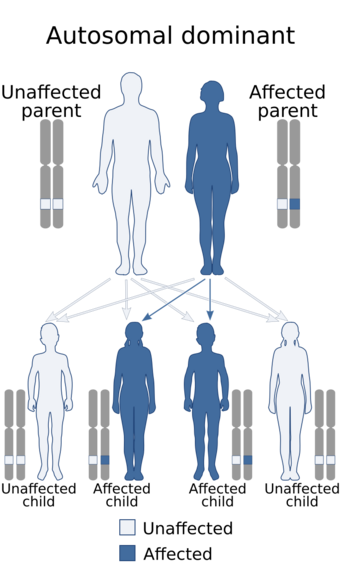Medicine:Léri–Weill dyschondrosteosis
Léri–Weill dyschondrosteosis or LWD is a rare pseudoautosomal dominant genetic disorder which results in dwarfism with short forearms and legs (mesomelic dwarfism) and a bayonet-like deformity of the forearms (Madelung's deformity).[1]
Causes
It is caused by mutations in the short-stature homeobox gene found in the pseudoautosomal region PAR1 of the X and Y chromosomes, at band Xp22.33 or Yp11.32.[2]
SHOX gene deletions have been identified as the major cause of Leri–Weill syndrome.[3]
Leri–Weill dyschondrosteosis is characterized by mesomelic short stature, with bowing of the radius more so than the ulna in the forearms and bowing of the tibia while sparing the fibula.[citation needed]
Diagnosis
Diagnosis is made following genetic blood testing.[citation needed]
Treatment
History
LWD was first described in 1929 by André Léri and Jean A. Weill.[4][5]
References
- ↑ "A Novel Class of Pseudoautosomal Region 1 Deletions Downstream of SHOX Is Associated with Léri–Weill Dyschondrosteosis". Am. J. Hum. Genet. 77 (4): 533–44. October 2005. doi:10.1086/449313. PMID 16175500.
- ↑ "Identification and characterization of different SHOX gene deletions in patients with Leri–Weill dyschondrosteosys by MLPA assay". J. Hum. Genet. 52 (1): 21–7. 2007. doi:10.1007/s10038-006-0074-5. PMID 17091221.
- ↑ "Identification and characterization of cryptic SHOX intragenic deletions in three Japanese patients with Léri–Weill dyschondrosteosis". J. Hum. Genet. 53 (5): 454–9. 2008. doi:10.1007/s10038-008-0269-z. PMID 18322641.
- ↑ synd/1662 at Who Named It?
- ↑ "Une affection congénitale et symétrique du développement osseux. La dyschondrostéose". Bulletins et Mémoires de la Société Médicale des Hôpitaux de Paris 53: 1491–1494. 1929.
External links
| Classification | |
|---|---|
| External resources |
 |


